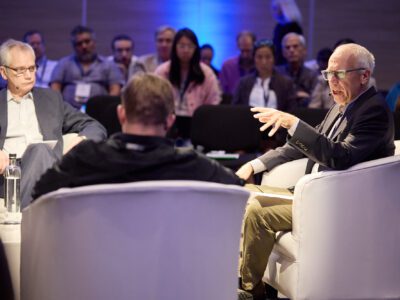Solar Geoengineering in the News — Again and Again
An update on the serious and the silly
 Solar geoengineering has been prominent in the news lately. It looks like the long-predicted spike of attention to these potential climate responses may finally be starting – with many attendant opportunities for controversy and confusion.
Solar geoengineering has been prominent in the news lately. It looks like the long-predicted spike of attention to these potential climate responses may finally be starting – with many attendant opportunities for controversy and confusion.
For background on solar geoengineering, why it’s important to research, and what the debates over it are, check out various prior LP posting from Emmett Institute researchers here, here, here, here, here, and here.
The current spike of news coverage spans a wide range from the serious to the silly. Highlights include:
-
- A tiny startup firm, “Make Sunsets,” launched a couple of weather balloons with a few grams of SO2 in late 2022 from a private property in Baja California, Mexico. After publicity of their announcement provoked a statement of disavowal from the Government of Mexico, they subsequently relocated to Reno, Nevada.
- A similar action – a couple of small, off-the-shelf weather balloons carrying a few hundred grams of SO2 to the stratosphere – was recently disclosed to have taken place in England in September 2022, with better documentation and flight engineering than the Make Sunsets flights. A report from that balloon flight and a prior failed one is now under review at a scientific journal.
- A few firms are proposing to spray “iron salt aerosols” – ferric chloride, FeCl3, or related compounds containing iron and chlorine – from ships. Proponents claim the process will replicate phytoplankton fertilization by iron-rich dust blown into the oceans during ice ages, and that it will help limit climate change through several mechanisms – most prominently by oxidizing atmospheric methane.
-
- Even highly speculative thought-experiment proposals, such as a recent paper proposing to shield sunlight by blasting dust off the new moon, are getting prominent press coverage.
-
- The US National Oceanic and Atmospheric Administration (NOAA) began a new phase of a research program in February, including stratospheric flights with old bombers converted to research aircraft carrying multiple instruments to do baseline observations of present stratospheric conditions. This new phase continues a small (about $10M/year) research program authorized by Congress since 2002, and follows a prior phase of modeling and balloon observations.
Several additional announcements related to solar geoengineering research are expected soon. In response to a mandate in the 2022 Appropriations Bill, a working group convened by the White House Office of Science and Technology Policy (OSTP) has been working for a year to plan a five-year US federal research program. The American Geophysical Union is preparing a statement on ethics of geoengineering research. The soon expected Synthesis Report from the IPCC’s Sixth Assessment Cycle, eagerly anticipated on March 20, might move the ball on IPCC’s thus-far limited willingness to engage debates over solar geoengineering.
Understanding these recent events and their significance requires some context. As the Legal Planet stories linked above summarize, solar geoengineering (SG) presents a high-stakes mix of promised reduction in near-term climate risks not achievable through other responses alone, along with new risks and uncertainties and major new challenges to international governance.
This uncertain, high-stakes state of affairs might seem to support a stance of precaution and investigation: Don’t rely on SG working and being acceptable, don’t slacken efforts on other essential climate responses, and on all accounts don’t try to do SG. But do research to try to understand whether and how it might work, with what side effects, and try to figure out how to govern it effectively, safely, and justly. While it may come as a surprise to those new to the issue, this seemingly precautionary stance has met strong resistance. Debate has been particularly sharp over proposed small field-research experiments – experiments that would inject small amounts of materials into the atmosphere to observe local chemical, radiative, and climate responses.
Opponents of SG research have advanced a wide range of claims, of which two are credible and serious. The first is that some form of socio-technical lock-in mechanism will cause research to expand into deployment, even if a fair reading of the evidence would judge this harmful or inadvisable. The second builds on long-standing concerns that over-reliance on SG might weaken resolve for needed emissions cuts, to suggest that even researching or discussing SG might trigger such over-reliance and weakening of other essential efforts.
The most prominent recent statement against SG research appeared in an open letter calling for a “non-use agreement” (NUA) and a supporting paper published in WIRES Climate Change, both in January, 2022. I regard both these documents as dangerously wrong-headed and misleading, but will save my detailed criticisms for another post, as a few co-authors and I have a paper under review that responds to their arguments in detail. For purposes of this post, there are two highlights: that the NUA proposal and supporting paper purport to target only “use” of SG and not block research, when their actual proposals would in fact block all or virtually all research; and that, like all other recent anti-SG-research arguments, they treat potential risks and harms related to SG in isolation, with no consideration of the linked risks of climate change or the prospect of rapid, single-minded, possibly coercive pursuit of other responses that SG might help to alleviate. (For a more sympathetic reading of the NUA proposal and supporting paper, see the recent LP post by Emmett Geoengineering Governance Fellow Duncan McLaren.)
Over the past few weeks, three other prominent statements have appeared, which propose more responsible paths forward on the potential role of SG and SG research in climate response – two open letters by international groups of climate scientists here and here, and one report by an international expert panel established by the UN Environment Programme. The three statements differ in many details, but are consistent in a set of core messages:
-
- They all stress the primary and essential role of deep emissions cuts and adaptation in climate response, while also recognizing the likelihood that these may, even with greatly increased efforts, be insufficient to limit climate risks.
- They all identify the high-stakes mix of promise, risk, governance challenges, and uncertainties that SG presents.
- They all forcefully reject any near-term proposal to deploy SG, and affirm the need to avoid unwarranted reliance on SG being available, effective, and acceptable, lest it undermine essential, overdue efforts on other responses.
- And they all stress the need to expand broadly participatory research on SG methods, effects and risks, and efforts to develop effective and just global governance.
The most significant differences between these statements concern how to conduct the recommended expansion of research – in particular, what additional governance, if any, is required specifically for research related to SG, beyond normal governance processes for scientific research. This is also the area of most serious uncertainty and disagreement among those active in the debate – even setting aside disingenuous demands for research governance processes so aspirational and burdensome that they are equivalent to a ban on research.
Although a great deal more work is needed to establish a path forward on SG research, a few points are well established:
-
- Research – on SG, and in general, is not ungoverned, but is subject to a wide range of governance requirements via peer review and other scientific processes, funder requirements, access to publication outlets and professional fora, plus existing environmental, health, safety, employment, financial, and other authoritative regulations. In addition, research is subjected to specific additional regulations when there are concerns that research might do direct harm (e.g., human subjects research, treatment of research animals) or there are obvious, direct pathways to subsequent harm (certain types of weapons and dual-use technologies).
- Claims that SG research needs and lacks governance normally refer to governance based on subject-matter. It is correct that research is generally not governed on this basis, including based on concerns about what errors or wrongs people might do with the knowledge or capability generated by the research – except for the weapons cases noted above. There are perennial calls for research governance based on such indirect concerns, but they are rarely adopted.
- In the case of SG-related research, some controls based on widespread concerns about indirect effects are widely agreed and might be relatively uncontroversial to enact, at least as soft-law governance. These include, for example, expectations for enhanced transparency and disclosure, including objectives, participants, and sources of funding and other support; promotion of international collaboration with special focus on strengthening Global South participation; and breakpoints or off-ramps for scale or intensity of active perturbation experiments. The one type of proposed governance requirement that is likely to be more challenging and contentious is related to public consultation requirements, particularly if they carry some degree of granting authoritative external control over what research questions are pursued using what methods.
Yet very little progress toward these seemingly reasonable aims has been achieved. Relative to evident value and need, research, researchers, and resources to support research are woefully short. In my opinion, it is clear that this is the result of the sustained and intense opposition mobilized against SG research within the small community attending to the issue, from some NGOs and academics. It is entirely reasonable for climate researchers who have observed the brazen misrepresentations, vilification, and death threats that the Harvard group has received in response to their proposals to do the Scopex experiment – which, it bears reminding, the group has repeatedly decided not to take forward – to decide they don’t need that trouble and choose to work on other questions. The prohibitionist camp also, in my view, bears responsibility for the silly stunts and dangerously premature attempts to commercialize SRM that we are now seeing. When funders and researchers who want to act responsibly and care about their reputations are scared away but the demand or need is great, what happens? Like other zealous prohibitionists before them, the prohibitionists are creating the conditions for emergence of the bootlegging industry, the dangerous back-alley abortionists.
We are thus in a dangerous place – relative to understanding the potential role and limits of SRM, and thus more broadly, relative to the totality of available responses to limit climate change. Is there a way out? We can certainly expect a continuation of silly theatrical stunts and deceptive premature attempts to commercialize SRM. Trying to stamp these out is a fool’s errand. They are presently legal, they are dirt-cheap, they are doing no direct environmental harm, and they are so similar to activities done by hundreds of science clubs and high-school classes, that the prospect of legal prohibition seems ludicrous. For me, the clearest path toward credible research in support of effective climate risk management runs through publicly funded research programs in democratic jurisdictions with strong scientific and transparency norms, with rapid international expansion prioritizing countries of the Global South. There is also need for a highly credible global assessment process for current knowledge and research priorities on SRM. Research programs can include additional, issue-specific governance processes so long as the burden is limited, falling far short of being equivalent to prohibition. We’re starting from a bad place, where research conduct and support by actors with the greatest scientific credibility and commitment to public benefit has been selectively deterred, but I believe there is a way back. It is even possible that reaction to the present collection of silly stuff will help start to move things in that positive direction.







Reader Comments